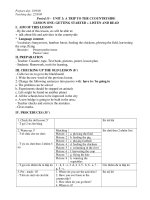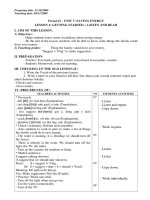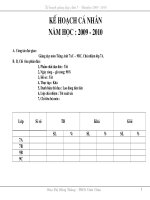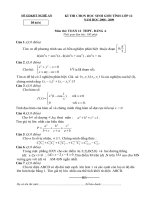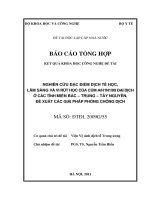Astm a 892 09 (2014)e1
Bạn đang xem bản rút gọn của tài liệu. Xem và tải ngay bản đầy đủ của tài liệu tại đây (66.72 KB, 2 trang )
Designation: A892 − 09 (Reapproved 2014)´1
Standard Guide for
Defining and Rating the Microstructure of High Carbon
Bearing Steels1
This standard is issued under the fixed designation A892; the number immediately following the designation indicates the year of
original adoption or, in the case of revision, the year of last revision. A number in parentheses indicates the year of last reapproval. A
superscript epsilon (´) indicates an editorial change since the last revision or reapproval.
ε1 NOTE—Units statement was inserted in Section 1.5 editorially in October 2014.
2.2 ASTM Adjuncts:
Photomicrographs for Defining and Rating the Microstructure of High Carbon Bearing Steels3
1. Scope
1.1 This guide covers the description of carbide structures in
annealed high carbon bearing steels.
1.2 Included is a guide for rating steel specimens by a
graded series of photomicrographs showing the incidence of
certain conditions.
3. Apparatus
3.1 In order to adequately compare the structure of a
specimen with the photomicrographs, it will be necessary to
view a properly prepared sample at 1000× magnification with
good resolution.
1.3 The reference photomicrographs are graded illustrations
of annealed carbides categorized by size, network, and lamellar
content (shape).
4. Specimen Preparation
1.4 This guide is to facilitate communication and description of microstructure. It does not establish limits of acceptability. Such limits are a matter of agreement between user and
producer.
4.1 Samples that represent a portion of the cross section of
the material shall be prepared using the practices described in
Guide E3. The size of the sample shall be negotiated between
the user and the producer. It may be a full cross section but
should not be too large for practical handling in the polishing
operation.
1.5 The values stated in SI units are to be regarded as
standard. No other units of measurement are included in this
standard.
1.6 This standard does not purport to address all of the
safety concerns, if any, associated with its use. It is the
responsibility of the user of this standard to establish appropriate safety and health practices and determine the applicability of regulatory limitations prior to use.
4.2 The properly polished specimens shall be etched in a
suitable etchant which will clearly delineate the annealed
carbide structure of the material being examined as described
in Practice E407. Nital (2 %) will frequently be an adequate
etchant for routine examination. When critical or detailed
analysis of structures is required, the recommended etchant is
Picral (saturated).
2. Referenced Documents
2.1 ASTM Standards:2
E3 Guide for Preparation of Metallographic Specimens
E407 Practice for Microetching Metals and Alloys
E1245 Practice for Determining the Inclusion or SecondPhase Constituent Content of Metals by Automatic Image
Analysis
5. Description
5.1 The reference photomicrographs (available in ASTM
Adjunct ADJA08923) are arranged into three categories, as
follows: carbide size (CS), carbide network (CN), and lamellar
content (LC).
5.2 Six photomicrographs for each category are provided
and are identified by category and number, for example,
CS1-CS6, CN1-CN6, and LC1-LC6. Higher numbers indicate
a larger number or greater degree of severity of the category
being rated.
1
This guide is under the jurisdiction of Committee A01 on Steel, Stainless Steel
and Related Alloys and is the direct responsibility of Subcommittee A01.28 on
Bearing Steels.
Current edition approved Oct. 1, 2014. Published October 2014. Originally
approved in 1988. Last previous edition approved in 2009 as A892 – 09. DOI:
10.1520/A0892-09R14E01.
2
For referenced ASTM standards, visit the ASTM website, www.astm.org, or
contact ASTM Customer Service at For Annual Book of ASTM
Standards volume information, refer to the standard’s Document Summary page on
the ASTM website.
3
Available from ASTM International Headquarters. Order Adjunct No.
ADJA0892. Original adjunct produced in 2009.
Copyright © ASTM International, 100 Barr Harbor Drive, PO Box C700, West Conshohocken, PA 19428-2959. United States
1
A892 − 09 (2014)´1
5.2.1 Actual counted number of carbides per 400 µm2
determined from the carbide size series of photomicrographs is
as follows (reported counts are the average of three measurements):
CS1 508
CS2 419
CS3 324
CS4 234
CS5 165
CS6 115
separate field may be used for each category or a single field
may be rated for more than one category. An example rating is
CS4, CN2, LC1.
6.2 As an alternate method, the rating of carbide size by
automatic image analysis shall be conducted in accordance
with Practice E1245. The rating shall be defined by the
following equation:
Rating 5 6.7888 2 4.5924 ~ 1026 ! *n A
(1)
where:
nA = number of carbides per mm2.
The results shall be rounded to the nearest integer value from
1 to 6.
6. Procedure for Evaluation
6.1 Using an optical metallograph and a magnification of
1000×, examine a properly prepared and etched specimen.
Select a field which is representative of the category to be
graded and compare it to the photomicrographs which are part
of this method. The rating will be the number of that photo that
most closely resembles the appearance of the specimen. A
7. Keywords
7.1 antifriction bearings; bearing steel; chromium alloy
steel; metallography
ASTM International takes no position respecting the validity of any patent rights asserted in connection with any item mentioned
in this standard. Users of this standard are expressly advised that determination of the validity of any such patent rights, and the risk
of infringement of such rights, are entirely their own responsibility.
This standard is subject to revision at any time by the responsible technical committee and must be reviewed every five years and
if not revised, either reapproved or withdrawn. Your comments are invited either for revision of this standard or for additional standards
and should be addressed to ASTM International Headquarters. Your comments will receive careful consideration at a meeting of the
responsible technical committee, which you may attend. If you feel that your comments have not received a fair hearing you should
make your views known to the ASTM Committee on Standards, at the address shown below.
This standard is copyrighted by ASTM International, 100 Barr Harbor Drive, PO Box C700, West Conshohocken, PA 19428-2959,
United States. Individual reprints (single or multiple copies) of this standard may be obtained by contacting ASTM at the above
address or at 610-832-9585 (phone), 610-832-9555 (fax), or (e-mail); or through the ASTM website
(www.astm.org). Permission rights to photocopy the standard may also be secured from the Copyright Clearance Center, 222
Rosewood Drive, Danvers, MA 01923, Tel: (978) 646-2600; />
2




